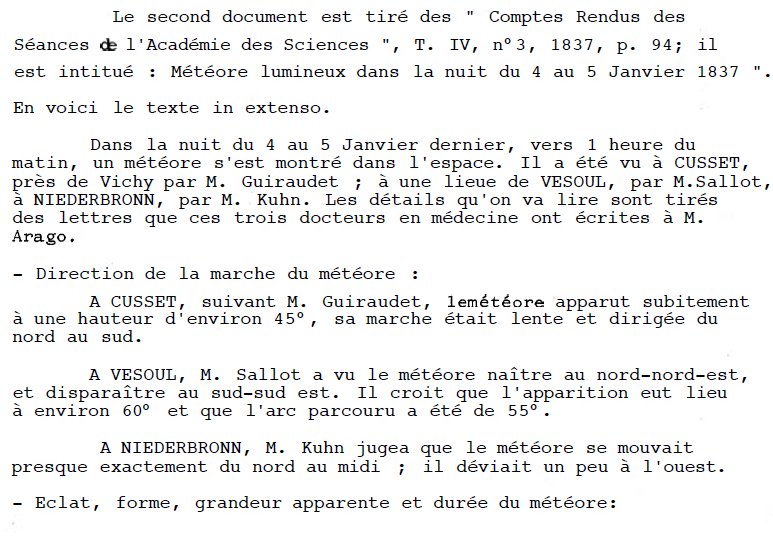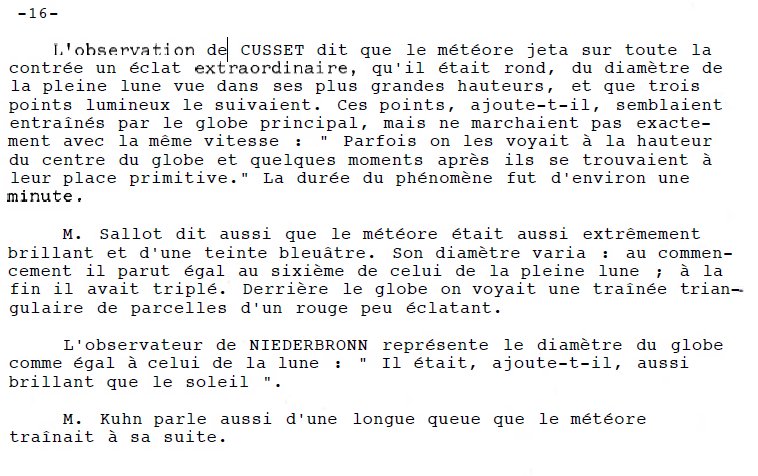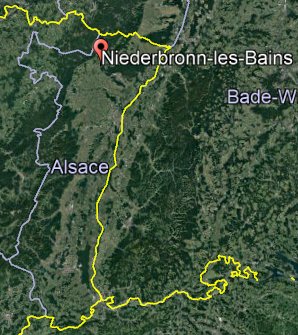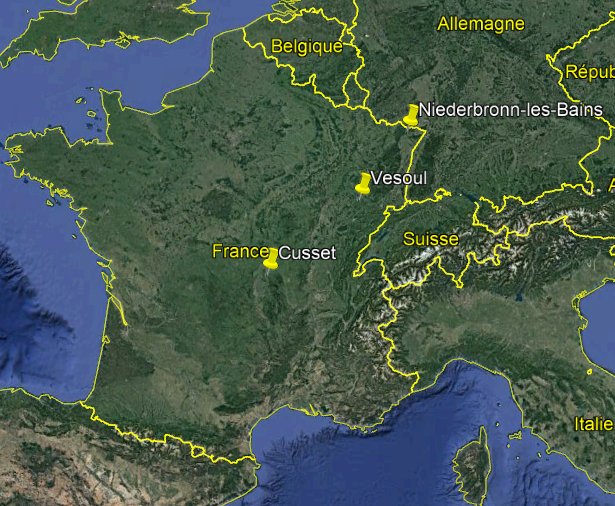ALSACAT-1837-01-05-NIEDERBRONN-1
Ufologist Jean Giraud and his wife published in 1977 that he found in the minutes of the French Sciences Academy of 1837 a report on a meteor; Giraud seemed to think that this meteor was "abnormal" although there is really nthing add about it.
The meteor event occurred on January 5, 1837, at approximately 1 a.m. The reports and observations places whow it was going from North-East to South-West.
It was first spotted in Niederbronn-les-Bains in Alsace by a Mr. Kuhn, who said it was as big as the moon and as shiny as the Sun, and had a long trail.
| Date: | January 5, 1837 |
|---|---|
| Time: | 01:00 a.m. |
| Duration: | ? |
| First known report date: | 1837 |
| Reporting delay: | Jour, mois. |
| Department: | Bas-Rhin |
|---|---|
| City: | Niederbronn-les-Bains |
| Place: | ? |
| Latitude: | 48.952 |
| Longitude: | 7.643 |
| Uncertainty radius: | 3 km. |
| Number of alleged witnesses: | 1 |
|---|---|
| Number of known witnesses: | 1 |
| Number of named witnesses: | 1 |
| Witness(es) ages: | Adult. |
| Witness(es) types: | Man, maybe astronomer. |
| Reporting channel: | Letter to the Academy of Science. |
|---|---|
| Type of location: | ? |
| Visibility conditions: | Night |
| UFO observed: | Yes |
| UFO arrival observed: | ? |
| UFO departure observed: | Yes |
| Entities: | No |
| Photographs: | No. |
| Sketch(s) by witness(es): | No. |
| Sketch(es) approved by witness(es): | No. |
| Witness(es) feelings: | ? |
| Witnesses interpretation: | Meteor. |
| Hynek: | NL |
|---|---|
| ALSACAT: | Probable meteor. |
[Ref. oio1:] JEAN GIRAUD - MAGAZINE "OVNI INFO":

|
ON THE MYSTERIOUS BEHAVIOR OF METEORS
[... other case...]
The second document is taken from the "Comptes Rendus des Sessions de l'Académie des Sciences", T. IV, nr 3, 1837, p. 94; it is entitled: Luminous meteor in the night of January 4 to 5, 1837."
Here is the full text.
On the night of January 4 to 5, around 1 a.m., a meteor appeared in space. It was seen at CUSSET, near Vichy by M. Guiraudet; at one league from VESOUL, by Mr. Sallot, at NIEDERBRONN, by M. Kuhn. The details we will read are taken from the letters that these three medical doctors wrote to Mr. Arago.
- Direction of the meteor's march:
CUSSET, according to Mr. Guiraudet, the meteor suddenly appeared at a height of about 45°, its course was slow and directed from north to south.
In VESOUL, Mr. Sallot saw the meteor appear in the north-northeast, and disappear in the south-southeast. He believes that the apparition took place at about 60° and that the arc traveled was 55°.
At NIEDERBRONN, Mr. Kuhn judged that the meteor was moving almost exactly from north to south; it deviated a little to the west.
- Brightness, shape, apparent size and duration of the meteor:

|
CUSSET's observation says that the meteor threw an extraordinary glow over the whole country, that it was round, the diameter of the full moon seen in its greatest heights, and that three luminous dots followed it. These dots, he adds, seemed to be driven by the main globe, but did not move with exactly the same speed: "Sometimes they were seen at the height of the center of the globe and a few moments later they were in their original place." The duration of the phenomenon was about a minute.
Mr. Sallot also said that the meteor was also extremely bright and of a bluish tint. Its diameter varied: at the beginning it seemed equal to a sixth of that of the full moon; in the end he had tripled. Behind the globe a triangular trail of plots of a faint red color were seen.
The NIEDERBRONN observer represents the diameter of the globe as equal to that of the moon: "It was, he adds, as bright as the sun".
Mr. Kuhn also speaks of a long tail that the meteor dragged after him.
[... other case...]
Henri MAURAS
Maître Assistant à
la Faculté des Sciences
Université Paul SABATIER

|
Jean Giraud seems to think that there was something abnormal with this meteor. But I really do not see what.
There are obviously differences in appearance for the three observers, who are probably not at the same distance, and who do not necessarily see it from the same angle. That its color might change is not unusual, that there are loose fragments is nothing abnormal.

|
Niederbronn must be the first place of observation since Mr. Kuhn says it "was moving almost exactly north to south; it was deviating a bit to the west." We will smile at the lack of precision, but we can clearly see that the direction is from North-East to South-West, towards Vesoul where it is then seen.
Now we are told that in Vesoul, "Mr. Sallot saw the meteor appear in the north-northeast, and disappear in the south-southeast." Which is accurate.
In Cusset, we are told, it went "from north to south." This is not totally correct, it must have been northeast to southwest. But depending on the relative position of the observer, the error is perfectly possible.
In 1837, we could hardly hope for a more precise report.
The observers should have given observation angles, two, that of the beginning and that of the end of observation; or geographic landmarks.
Probable meteor.
* = Source is available to me.
? = Source I am told about but could not get so far. Help needed.
| Main author: | Patrick Gross |
|---|---|
| Contributors: | None |
| Reviewers: | None |
| Editor: | Patrick Gross |
| Version: | Create/changed by: | Date: | Description: |
|---|---|---|---|
| 0.1 | Patrick Gross | June 16, 2021 | Creation, [ioi1]. |
| 1.0 | Patrick Gross | June 16, 2021 | First published. |